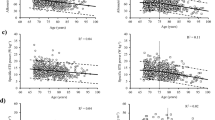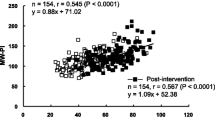Abstract
Objective
To determine whether there was an association between the Five-Times-Sit-to-Stand test (FTSS) and the global cognitive function assessed with Short-Portable-Mental-State-Questionnaire (SPMSQ) among the EPIDOS cohort.
Design
Cross-sectional study corresponding to the baseline assessment of the EPIDOS study.
Setting
Five French cities including Amiens, Lyon, Montpellier, Paris and Toulouse.
Participants
7421 community-dwelling older women (mean age 80.41±0.04 years).
Measurements
Time to achieve FTSS, and SPMSQ score. Age, body mass index, high number of comorbidities, cardiovascular risk factors, depression, regular physical activity, joint pain, quadriceps strength, visual acuity, use of psychoactive drugs, serum albumin, vitamin D deficiency (i.e., serum concentration <10ng/mL), and the influence of seasons and study centers were used as covariables. Subjects were divided into 2 groups according to SPMSQ score (either impaired < 8/10 or normal ≥ 8/10).
Results
Compared to their counterparts, the women with cognitive impairment (n=1190, mean 81.51±0.45years) took more time in performing FTSS (17.8±0.9seconds versus 16.1±0.3seconds, P < 0.001). There was a significant negative association of SPMSQ score with FTSS (Unadjusted β=−0.02(95%CI −0.03;−0.01), P<0.001; Fully Adjusted β=−0.03(95%CI −0.05;−0.01), P=0.003; Stepwise Backward Adjusted β=−0.02(95%CI −0.04;−0.01), P=0.005), as well as with advance in age (β=−0.04, P=0.006) and vitamin D deficiency (β=−0.34, P=0.011). The FTSS limit value in predicting moderate cognitive impairment was set at 15 seconds by a sensitivity analysis (negative predictive value=86%).
Conclusion
We found a negative association of FTSS with global cognitive performance. Achieving FTSS in less than 15 seconds made unlikely the existence of a moderate cognitive impairment. FTSS could be used as a tool in primary care medicine to exclude moderate cognitive decline.
Similar content being viewed by others
Abbreviations
- FTSS:
-
Five-Times-Sit-to-Stand test
- SPMSQ:
-
Short Portable Mental State Questionnaire
- EPIDOS:
-
EPIDémiologie de l’OStéoporose study
- BMI:
-
Body Mass Index
- 3MS:
-
Modified Mini Mental State
- MMSE:
-
Mini Mental State Examination
References
Jorm AF, Jolley D (1998) The incidence of dementia: A meta-analysis. Neurology 51:728–733.
French National Plan for “Alzheimer and related diseases” 2008–2012. http://www.plan-alzheimer.gouv.fr/mesures-en/sommaire_44_mesures.html. Accessed 26 April 2010.
Iliffe S, Robinson L, Brayne C, Goodman C, Rait G, Manthorpe J, Ashley P; DeNDRoN Primary Care Clinical Studies Group (2009) Primary care and dementia: 1. diagnosis, screening and disclosure. Int J Geriatr Psychiatry 24:895–901.
Boustani M, Peterson B, Hanson L, Harris R, Lohr KN. U.S. Preventive Services Task Force (2003) Screening for dementia in primary care: a summary of the evidence for the U.S. Preventive Services Task Force. Ann Intern Med 138:927–937.
Ashford JW, Borson S, O’Hara R, Dash P, Frank L, Robert P, Shankle WR, Tierney MC, Brodaty H, Schmitt FA, Kraemer HC, Buschke H, Fillit H (2007) Should older adults be screened for dementia? It is important to screen for evidence of dementia! Alzheimer Dement 3:75–80.
Marquis S, Moore MM, Howieson DB, Sexton G, Payami H, Kaye JA, Camicioli R (2002) Independent predictors of cognitive decline in healthy elderly persons. Arch Neurol 59:601–606.
Rosano C, Simonsick EM, Harris TB, Kritchevsky SB, Brach J, Visser M, Yaffe K, Newman AB (2005) Association between physical and cognitive function in healthy elderly: the health, aging and body composition study. Neuroepidemiology 24:8–14.
Verghese J, Wang C, Holtzer R, Lipton RB, Xue X (2007) Quantitative gait dysfunction and risk of cognitive decline and dementia. J Neurol Neurosurg Psychiatry 54:255–261.
Atkinson HH, Rosano C, Simonsick EM, Williamson JD, Davis C, Ambrosius WT, Rapp SR, Cesari M, Newman AB, Harris TB, Rubin SM, Yaffe K, Satterfield S, Kritchevsky SB; Health ABC study (2007) Cognitive function, gait speed decline, and comorbidities: the health, aging and body composition study. J Gerontol A Biol Sci Med Sci 62:844–850.
Takata Y, Ansai T, Soh I, Kimura Y, Yoshitake Y, Sonoki K, Awano S, Kagiyama S, Yoshida A, Nakamichi I, Hamasaki T, Torisu T, Toyoshima K, Takehara T (2008) Physical fitness and cognitive function in an 85-year-old community-dwelling population. Gerontology 54:354–360.
Guralnik JM, Branch LG, Cummings SR, Curb JD (1989) Physical performance measures in aging research. J Gerontol 44:M141–146.
Ble A, Volpato S, Zuliani G, Guralnik JM, Bandinelli S, Lauretani F, Bartali B, Maraldi C, Fellin R, Ferrucci L (2005) Executive function correlates with walking speed in older persons: the InCHIANTI study. J Am Geriatr Soc 53:410–415.
Coppin AK, Shumway-Cook A, Saczynski JS, Patel KV, Ble A, Ferrucci L, Guralnik JM (2006) Association of executive function and performance of dual-task physical tests among older adults: analyses from the InChianti study. Age Ageing 35:619–624.
Carlson MC, Fried LP, Xue QL, Bandeen-Roche K, Zeger SL, Brandt J (1999) Association between executive attention and physical functional performance in community-dwelling older women. J Gerontol B Psychol Sci Soc Sci 54:S262–270.
Raji MA, Ostir GV, Markides KS, Goodwin JS (2002) The interaction of cognitive and emotional status on subsequent physical functioning in older Mexican Americans: findings from the Hispanic Established Population for the Epidemiologic Study of the Elderly. J Gerontol Med Sci 57A:M678–682.
Seeman TE, Charpentier PA, Berkman LF, Tinetti ME, Guralnik JM, Albert M, Blazer D, Rowe JW (1994) Predicting changes in physical performance in a high-functioning elderly cohort: MacArthur Studies of Successful Aging. J Gerontol Med Sci 49A:M97–108.
Tabbarah M, Crimmins EM, Seeman TE (2002) The relationship between cognitive and physical performance: MacArthur Studies of Successful Aging. J Gerontol Med Sci 57A:M228–235.
Wang L, van Belle G, Kukull WB, Larson EB (2002) Predictors of functional change: a longitudinal study of nondemented people aged 65 and older. J Am Geriatr Soc 50:1525–1534.
Csuka M, McCarty DJ (1985) Simple method for measurement of lower extremity muscle strength. Am J Med 78:77–81.
Lord SR, Murray SM, Chapman K, Munro B, Tiederman A (2002) Sit-to-stand performance depends on sensation, speed, balance, and psychological status in addition to strength in older people. J Gerontol A Biol Sci Med Sci 57A:M539–543.
Whitney SL, Wrisley DM, Marchetti GF, Gee MA, Redfern MS, Furman JM (2005) Clinical measurement of sit-to-stand performance in people with balance disorders: Validity of data for the Five-Times-Sit-to-Stand test. Phys Ther 85:1034–1045.
Bohannon RW (2006) Reference values for the five-repetition sit-to-stand test: a descriptive meta-analysis of data from elders. Percept Mot Skills 103:215–222.
Buatois S, Miljkovic D, Manckoundia P, Gueguen R, Miget P, Vançon G, Perrin P, Benetos A (2008) Five times sit to stand test is a predictor of recurrent falls in healthy community-living subjects aged 65 and older. J Am Geriatr Soc 56:1575–1577.
Lusardi MM, Pellecchia GL, Schulman M (2003) Functional performance in community living older adults. J Geriatr Phys Ther 26:14–22.
Guralnik JM, Simonsick EM, Ferrucci L, Glynn RJ, Berkman LF, Blazer DG, Scherr PA, Wallace RB (1994) A short physical performance battery assessing lower extremity function: association with self-reported disability and prediction of mortality and nursing home admission. J Gerontol 49:M85–94.
Dargent-Molina P, Favier F, Grandjean H, Baudoin C, Schott AM, Hausherr E, Meunier PJ, Bréart G (1996) Fall-related factors and risk of hip fracture: the EPIDOS prospective study. Lancet 348:145–149.
Annweiler C, Schott AM, Montero-Odasso M, Berrut G, Fantino B, Herrmann FR, Beauchet O (2010) Cross-sectional association between serum vitamin D concentration and walking speed measured at usual and fast pace among older women: The EPIDOS study. J Bone Miner Res 25: 1858–1866”.
Jones CJ, Rikli RE, Beam WC (1999) A 30-s chair-stand test as a measure of lower body strength in community-residing older adults. Res Q Exerc Sport 70:113–119.
Bohannon RW, Smith J, Hull D, Palmeri D, Barnhard R (1995) Deficits in lower extremity muscle and gait performance among renal transplant candidates. Arch Phys Med Rehabil 76:547–551.
Pfeiffer EA (1975) A short portable mental state questionnaire for the assessment of organic brain deficit in elderly patients. J Am Geriatr Soc 50:1996–2002.
Erkinjuntti T, Sulkava R, Wikström J, Autio L (1987) Short Portable Mental Status Questionnaire as a screening test for dementia and delirium among the elderly. J Am Geriatr Soc 35:412–416.
Annweiler C, Schott AM, Allali G, Bridenbaugh SA, Kressig RW, Allain P, Herrmann FR, Beauchet O (2010) Association of vitamin D deficiency with cognitive impairment in older women. Cross-sectional study. Neurology 74:27–32.
Fried LP, Xue QL, Cappola AR, Ferrucci L, Chaves P, Varadhan R, Guralnik JM, Leng SX, Semba RD, Walston JD, Blaum CS, Bandeen-Roche K (2009) Nonlinear multisystem physiological dysregulation associated with frailty in older women: implications for etiology and treatment. J Gerontol A Biol Sci Med Sci 64:1049–1057.
Annweiler C, Beauchet O, Berrut G, Fantino B, Bonnefoy M, Herrmann FR, Schott AM (2009) Is there an association between serum 25-hydroxyvitamin D concentration and muscle strength among older women? Results from baseline assessment of the EPIDOS study. J Nutr Health Aging 13:90–95.
Catelan D, Biggeri A (2010). Multiple testing in disease mapping and descriptive epidemiology. Geospat Health. 4:219–229.
Hirsch CH, Fried LP, Harris T, Fitzpatrick A, Enright P, Schulz R (1997) Correlates of performance-based measures of muscle function in the elderly: The Cardiovascular Health Study. J Gerontol A Biol Sci Med Sci 52A:M192–200.
Wilson JM, Jungner YG (1968) Principles and practice of mass screening for disease. Bol Oficina Sanit Panam 65:281–293.
Malmstrom TK, Wolinsky FD, Andresen EM, Miller JP, Miller DK (2005) Cognitive ability and physical performance in middle-aged African Americans. J Am Geriatr Soc 53:997–1001.
Atkinson HH, Rapp SR, Williamson JD, Lovato J, Absher JR, Gass M, Henderson VW, Johnson KC, Kostis JB, Sink KM, Mouton CP, Ockene JK, Stefanick ML, Lane DS, Espeland MA (2010) The relationship between cognitive function and physical performance in older women: Results from the Women’s Health Initiative Memory Study. J Gerontol A Biol Sci Med Sci 65:300–306.
Blaum CS, Ofstedal MB, Liang J (2002) Low cognitive performance, comorbid disease, and task-specific disability: findings from a nationally representative survey. J Gerontol Med Sci 57A:M523–531.
Weuve J, Kang JH, Manson JE, Breteler MM, Ware JH, Grodstein F (2004) Physical activity, including walking, and cognitive function in older women. JAMA 292:1454–1461.
Larson EB, Wang L, Bowen JD, McCormick WC, Teri L, Crane P, Kukull W (2006) Exercise is associated with reduced risk for incident dementia among persons 65 years of age and older. Ann Intern Med 144:73–81.
Eggermont L, Swaab D, Luiten P, Scherder E (2006) Exercise, cognition and Alzheimer’s disease: more is not necessarily better. Neurosci Biobehav Rev 30:562–575.
Colcombe SJ, Erickson KI, Raz N, Webb AG, Cohen NJ, McAuley E, Kramer AF (2003) Aerobic fitness reduces brain tissue loss in aging humans. J Gerontol A Biol Sci Med Sci 58:176–180.
Colcombe SJ, Erickson KI, Scalf PE, Kim JS, Prakash R, McAuley E, Elavsky S, Marquez DX, Hu L, Kramer AF (2006) Aerobic exercise training increases brain volume in aging humans. J Gerontol A Biol Sci Med Sci 61:1166–1170.
Craik FI (2008) Memory changes in normal and pathological aging. Can J Psychiatry 53:343–345.
Annweiler C, Schott AM, Berrut G, Chauviré V, Le Gall D, Inzitari M, Beauchet O (2010) Vitamin D and ageing: Neurological issues. Neuropsychobiology 62:139–150.
Annweiler C, Allali G, Allain P, Bridenbaugh S, Schott AM, Kressig RW, Beauchet O (2009) Vitamin D and cognitive performance in adults: a systematic review. Eur J Neurol 16:1083–1089.
Author information
Authors and Affiliations
Corresponding author
Rights and permissions
About this article
Cite this article
Annweiler, C., Schott, A.M., Abellan Van Kan, G. et al. The Five-Times-Sit-to-stand test, a marker of global cognitive functioning among community-dwelling older women. J Nutr Health Aging 15, 271–276 (2011). https://doi.org/10.1007/s12603-011-0037-1
Received:
Accepted:
Published:
Issue Date:
DOI: https://doi.org/10.1007/s12603-011-0037-1




